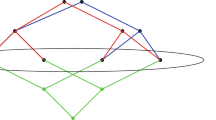Abstract
View ann-vertex,m-edge undirected graph as an electrical network with unit resistors as edges. We extend known relations between random walks and electrical networks by showing that resistance in this network is intimately connected with thelengths of random walks on the graph. For example, thecommute time between two verticess andt (the expected length of a random walk froms tot and back) is precisely characterized by the effective resistanceR st betweens andt: commute time=2mR st . As a corollary, thecover time (the expected length of a random walk visiting all vertices) is characterized by the maximum resistanceR in the graph to within a factor of logn:mR<-cover time<-O(mRlogn). For many graphs, the bounds on cover time obtained in this manner are better than those obtained from previous techniques such as the eigenvalues of the adjacency matrix. In particular, we improve known bounds on cover times for high-degree graphs and expanders, and give new proofs of known results for multi-dimensional meshes. Moreover, resistance seems to provide an intuitively appealing and tractable approach to these problems.
Similar content being viewed by others
References
D. J. Aldous, On the time taken by random walks on finite groups to visit every state.Z. Wahrsch. Verw. Gebiete 62(3) (1983), 361–374.
D. J. Aldous,Reversible Markov chains and random walks on graphs. 1993. Draft, University of California, Berkeley.
R. Aleliunas, R. M. Karp, R. J. Lipton, L. Lovász, and C. W. Rackoff, Random walks, universal traversal sequences, and the complexity of maze problems. InProc. 20th Ann. IEEE Symp. Found. Comput. Sci., San Juan, Puerto Rico, 1979, IEEE, 218–223.
N. Alon, Eigenvalues and expanders.Combinatorica 6(2) (1986), 83–96.
G. Barnes andU. Feige, Short random walks on graphs.SIAM J. Disc. Math. 9(1) (1996), 19–28.
A. Borodin, S. A. Cook, P. W. Dymond, W. L. Ruzzo, andM. Tompa, Two applications of inductive counting for complementation problems.SIAM J. Comput. 18(3) (1989), 559–578. See also18(6): 1283, December 1989.
A. Borodin, W. L. Ruzzo, andM. Tompa, Lower bounds on the length of universal traversal sequences.J. Comput. System Sci. 45(2) (1992), 180–203.
A. Z. Broder andA. R. Karlin, Bounds on the cover time.J. Theoret. Probability 2(1) (1989), 101–120.
A. Z. Broder, A. R. Karlin, P. Raghavan, andE. Upfal, Trading space for time in undirecteds-t connectivity.SIAM J. Comput. 23(2) (1994), 324–334.
A. K. Chandra, P. Raghavan, W. L. Ruzzo, R. Smolensky, and P. Tiwari, The electrical resistance of a graph captures its commute and cover times. InProc. Twenty-first Ann. ACM Symp. Theor. Comput., Seattle, WA, 1989, 574–586.
J. T. Cox, Coalescing random walks and voter model consensus times on the torus inZd.The Annals of Probability 17(4) (1989), 1333–1366.
P. G. Doyle, Personal communication, 1988.
P. G. Doyle and J. L. Snell,Random Walks and Electrical Networks. The Mathematical Association of America, 1984.
M. Dyer, A. M. Frieze, andR. Kannan, A random polynomial-time algorithm for approximating the volume of convex bodies.J. Assoc. Comput. Mach. 38(1) (1991), 1–17.
U. Feige, A randomized time-space tradeoff of\(\tilde O(m\hat R)\) for USTCON. InProc. 34th Ann. Symp. Found. Comput. Sci., Palo Alto, CA, 1993, IEEE, 238–246.
J. N. Franklin,Matrix Theory. Prentice-Hall, 1968.
J. Friedman and N. J. Pippenger, Expanding graphs contain all small trees.Combinatorica (1987), 71–76.
F. Göbel andA. A. Jagers, Random walks on graphs.Stochastic Processes and their Applications 2 (1974), 311–336.
M. Jerrum andA. Sinclair, Approximating the permanent.SIAM J. Comput. 18(6) (1989), 1149–1178.
J. D. Kahn, N. Linial, N. Nisan, andM. E. Saks, On the cover time of random walks on graphs.J. Theoret. Probability 2(1) (1989), 121–128.
H. J. Landau andA. M. Odlyzko, Bounds for eigenvalues of certain stochastic matrices.Linear Algebra and Its Applications 38 (1981), 5–15.
P. Matthews, Covering problems for Brownian motion on spheres.The Annals of Probability 16(1) (1988), 189–199.
J. C. Maxwell,A Treatise on Electricity and Magnetism. Clarendon, 1918.
D. Peleg andE. Upfal, Constructing disjoint paths on expander graphs.Combinatorica 9(3) (1989), 289–313.
S. M. Ross,Introduction to Probability Models. Academic Press, fourth edition, 1989.
R. Rubinfeld, The cover time of a regular expander isO(nlogn).Inform. Process. Lett. 35(1) (1990), 49–51.
J. L. Synge, The fundamental theorem of electrical networks.Quarterly of Applied Math. 9 (1951), 113–127.
P. Tetali, Random walks and effective resistance of networks.J. Theoret. Probability 4(1) (1991), 101–109.
W. Thomson and P. G. Tait,Treatise on Natural Philosophy. Cambridge, 1879.
D. I. Zuckerman, On the time to traverse all edges of a graph.Inform. Process. Lett. 38(6) (1991), 335–337.
D. I. Zuckerman, A technique for lower bounding the cover time.SIAM J. Disc. Math. 5(1) (1992), 81–87.
Author information
Authors and Affiliations
Rights and permissions
About this article
Cite this article
Chandra, A.K., Raghavan, P., Ruzzo, W.L. et al. The electrical resistance of a graph captures its commute and cover times. Comput Complexity 6, 312–340 (1996). https://doi.org/10.1007/BF01270385
Received:
Issue Date:
DOI: https://doi.org/10.1007/BF01270385




